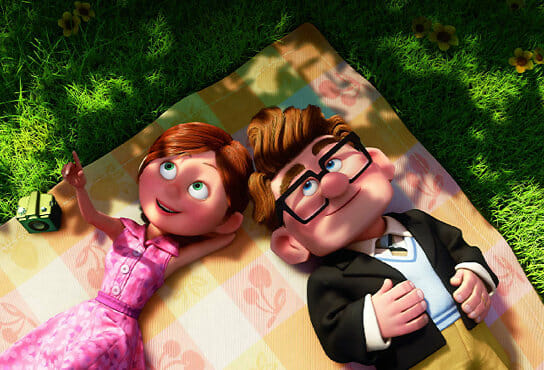By Michael Schilf · March 5, 2010

I have only cried twice at the movies. The first time, I could have filled buckets, watered a greenhouse, even put out a small fire. I was a struggling writer in Los Angeles, broke, unemployed, and – don’t tell my mother – homesick. The cause of my tears was the new release rental My Dog Skip. I had an empty glass, a cheap bottle of Shiraz, and that dog Skip was a dead ringer for my childhood mutt. Cry? How could I not?
But that was then. Now I’m tougher – married, three kids, a mortgage – I have to be. So I was surprised when I found myself wiping the corners of my eyes as I watched a brilliant little four minute film within a film. I cried – guilty a second time. And it was Pete Docter and Bob Peterson’s animated brainchild Up that did it.
But clearly I wasn’t the only one. Up grossed $723,004,164 worldwide, and I’m guessing that’s a lot of tears. And the fact that it took home the Golden Globe for Best Animated Feature Film – and will probably grab the Oscar as well – is nothing new for PIXAR. The studio that brought us Finding Nemo,The Incredibles, Ratatouille, and Wall-E clearly know what they are doing. And even though I could analyze dozens of elements of what I consider a near perfect movie, what is quite possibly the most impressive thing about Up is the four-minute, dialogue-free “Married Life” montage of Carl Fredricksen and his wife, Ellie, which takes us from their wedding day and fixing up their dream house, through the tragedy of Ellie’s miscarriage and the rekindled dream of ‘Paradise Falls’, to Ellie’s ill health, inevitable death, and Carl’s bereavement.
Now that’s a story. That’s an entire life. And all done in just over four minutes… without a single solitary word.
No dialogue. That’s how it all started over a century ago. From The Birth of a Nation (1915), the highest ever grossing silent film, to such classics as Way Down East (1920), Orphans of the Storm (1921), and The Gold Rush (1925), the filmmakers of these silent treasures didn’t ‘tell’ us with talking heads and forced exposition; they couldn’t. They showed us. Film is a visual medium, after all.
Pete Docter and co-director and co-screenwriter Bob Peterson went back to basics and showed us a beautiful little story in 49 poignant scenes in exactly 4 minutes 18 seconds. I’ve watched the “Married Life” montage half a dozen times, and through each viewing I can’t find one single image, one second of screen time that I would argue as unwarranted.
“It’s one of the things I am most proud of in the film,” Docter says. “You start with a ton of stuff and you pare down, and we took out everything that wasn’t essential.”
Now that is some serious script economy. But why go silent? Surely, at least a sound effect or two – maybe a POP when the car tire blows or when the hammer SHATTERS the glass coin jug again, and again, and again – would add to the visual experience?
Not so. In researching the film, Docter and Peterson looked at a number of Super-8 film reels from family archives and often found that the silent images were more memorable because of what wasn’t said.
“We’re always looking in animation to do things without dialogue, to turn the sound off and still know what’s going on,” Peterson explains.
Peterson, who is also the voice of the devoted dog Dug (”My name is Dug. I have just met you, and I love you”), couldn’t be more correct. And I believe that we need to see more of it in Hollywood, but not just in animation. Talk is cheap and actions really do speak louder than words, so let’s learn from Docter and Peterson, two of the best screenwriters in the business. Take the dialogue out, see what happens.
Up is an amazing piece of filmmaking, and I think film critic Kenneth Turan says it best when describing Up as “a small gem that will stay with you for a lifetime.” I know it will for me.